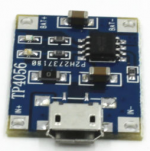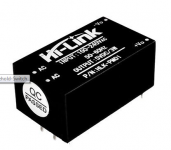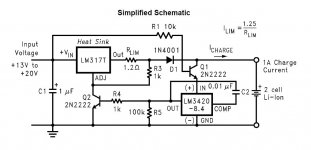I almost never used dedicated Li-Ion charger. Laboratory supply set to n*4.15V and 0.2...1C current always worked, unless battery is unbalanced or over-discharged. If unbalanced, then it needs to be balanced first (charging lower voltage to the same level as the higher).
If overdischarged, then an attempt can be made to recover with very small (0.005...0.02 C) current, and if it is restored in 1 hour (restored: low impedance and stable 3.4...3.6V), then normal charging (0.1C) can be started. Without this slow charging overdischarged batteries often fail.
ConstantCurrentConstantVoltage charger can be made by cascading a current limiter and a voltage regulator (preferably LowDropOut type).
I don't know how to make a simple automatic slow charger...
If overdischarged, then an attempt can be made to recover with very small (0.005...0.02 C) current, and if it is restored in 1 hour (restored: low impedance and stable 3.4...3.6V), then normal charging (0.1C) can be started. Without this slow charging overdischarged batteries often fail.
ConstantCurrentConstantVoltage charger can be made by cascading a current limiter and a voltage regulator (preferably LowDropOut type).
I don't know how to make a simple automatic slow charger...
I am also in the need of a similar charger for my project that runs on +-7,4V from two small 2S 300mAh batteries. This system is a very low noise pre amplifier and the batteries will be installed together with the electronics inside a triple shielded mu-metal/copper enclosure The charger must also be permanently installed in the device (in the outermost enclosure) so that the user just have to plug in a power source to recharge the batteries when needed. The charging must be totally automatic.
I want to charge the batteries with a current of 300mA. It would be nice if I could just buy the charger, but I cannot find any ready made product that does this. The only product I have found requires the user to input charging current through push-buttons / menues etc.
The plan so far is to build a charger around the TP4056 chip. I just bought 20 pcs. on ebay. The plan is to make a circuit with these to charge all four cells simultaneous with one chip per cell. The obvious problem is that the "ground" potential changes for cell 2, 3 and 4 and current will flow somewhat odd through the system. I haven't offered this much thought yet bur it must be possible somehow. Is there a solution for this out there?
I want to charge the batteries with a current of 300mA. It would be nice if I could just buy the charger, but I cannot find any ready made product that does this. The only product I have found requires the user to input charging current through push-buttons / menues etc.
The plan so far is to build a charger around the TP4056 chip. I just bought 20 pcs. on ebay. The plan is to make a circuit with these to charge all four cells simultaneous with one chip per cell. The obvious problem is that the "ground" potential changes for cell 2, 3 and 4 and current will flow somewhat odd through the system. I haven't offered this much thought yet bur it must be possible somehow. Is there a solution for this out there?
there are a few li-ion charger chips out there. the main danger is charging cells that are too far discharged. if you charge them at high rata they may explode.
li-ion cells need a protection circuit to avoid the deep discharge. charging in series needs a balancing circuit. or you need to charge each cell individually..
not as simple as it seems indeed...
li-ion cells need a protection circuit to avoid the deep discharge. charging in series needs a balancing circuit. or you need to charge each cell individually..
not as simple as it seems indeed...
An lm317 can be used for a CCS, another lm317 can be used for voltage regulator...............
ConstantCurrentConstantVoltage charger can be made by cascading a current limiter and a voltage regulator (preferably LowDropOut type). ...............
These two lm317 in cascade (CCS first) make a very simple constant current/constant voltage charger. And Very cheap to experiment with.
This works very well for lead acid and NiCad. It seems to work well for Nimh.
I cannot recommend this style of charger for Lithium batteries.
Simple charger
I found a simple way to do this for my project
TP4056 5V Micro USB 1A Lithium Battery Charging Board

HLK-PM01 AC-DC 220V to 5V Step-Down Power Supply Module

With four of each I can charge the two batteries automatically by connecting to the mains. Total price about 14 USD.
I just have to change one resistor on the small boards to 4k to achieve 300mA charging current.
The TP4056 draws only 2.5uA from the batteries so it can always be connected.
I found a simple way to do this for my project
TP4056 5V Micro USB 1A Lithium Battery Charging Board

HLK-PM01 AC-DC 220V to 5V Step-Down Power Supply Module

With four of each I can charge the two batteries automatically by connecting to the mains. Total price about 14 USD.
I just have to change one resistor on the small boards to 4k to achieve 300mA charging current.
The TP4056 draws only 2.5uA from the batteries so it can always be connected.
An lm317 can be used for a CCS, another lm317 can be used for voltage regulator.
These two lm317 in cascade (CCS first) make a very simple constant current/constant voltage charger. And Very cheap to experiment with.
This works very well for lead acid and NiCad. It seems to work well for Nimh.
I cannot recommend this style of charger for Lithium batteries.
Why?
For NiMH the recommended charging method is quite complicated, much different from CC-CV:
https://na.industrial.panasonic.com...nloads/files/panasonic_nimh_chargemethods.pdf
But anywhere you look, CC-CV is the recommended charging method for Li-Ion:
https://www.google.hu/search?q=li-i...4u5zLAhWjApoKHbmOA7cQ_AUIBigB&dpr=0.9#imgrc=_
Fear is not a technical reason.
Many things are more probable than this. Don't create reason from lack of information! You know no technical detail about this story.
Damage during charging?
Many things are more probable than this. Don't create reason from lack of information! You know no technical detail about this story.
Here is one that has protection from overcharging. I have some and they work great. I recharge my 8.4V in two separate stages, 4.2V on each unit of 3 cells. Buy 2, and you can you can charge both groups of 3 cells simultaniously using 3 wires. Some Kind of connecting socket is recommended. Using clips, it is too easy to get the leads reversed, especially when you feel tired.
5V Micro USB 1A 18650 Lithium Battery Charging Board Charger Module New EK | eBay
5V Micro USB 1A 18650 Lithium Battery Charging Board Charger Module New EK | eBay
Last edited:
Here is one that has protection from overcharging. I have some and they work great. I recharge my 8.4V in two separate stages, 4.2V on each unit of 3 cells. Buy 2, and you can you can charge both groups of 3 cells simultaniously using 3 wires. ...
How 3 cells come to 3 wires, 8.4 V???
But anyhow there is a problem with this simultaneous charging. 2 chargers are not identical. 1 has higher voltage than the other, so 1 cell is charged more. When you discharge both in series, the other will empty earlier, and depending on the way of usage it can go to overdischarge, which reduces lifetime. It's better to match them at discharged state, charge and discharge strictly identical, not to charge them up to the limit, and check balance sometimes.
First of all, have a look at this.
https://www.youtube.com/watch?v=Qw4psECqpwI
My 9V battery is two 18650 batteries taking from a defunct computer battery pack connected in series.
Inside the 18560 package are three cells, each 1.4V giving 4.2V fully charged.
I charge each group of 3 cells to 4.2V, separately, using the charger module as in the video. On charging, each 18560 will become fully charged, and stay in balance with each other.
.
https://www.youtube.com/watch?v=Qw4psECqpwI
My 9V battery is two 18650 batteries taking from a defunct computer battery pack connected in series.
Inside the 18560 package are three cells, each 1.4V giving 4.2V fully charged.
I charge each group of 3 cells to 4.2V, separately, using the charger module as in the video. On charging, each 18560 will become fully charged, and stay in balance with each other.
.
https://www.youtube.com/watch?v=1Fs...kXjFMoue2ws_peUHseA5nVa_WI40hacBZmu_AWW5PV6JA
Here is more information on charging battery packs.
Here is more information on charging battery packs.
+1If you're not experienced with Li-Ion charging I would recommend getting a charge controller for them, you can buy them really cheap on eBay.
I reckon yer looking at LiPo instead of more modern safer Li ion cells. these are older tech and mostly for 'hobby' type apps.
do more homework on the internet instead of soliciting circuit ideas here for some unknown cells. identify the cells then look around.
I cant. My mobile internet is limited. You'd better write or attach picture. This is like the forum intended to use.
My 9V battery is two 18650 batteries taking from a defunct computer battery pack connected in series.
Inside the 18560 package are three cells, each 1.4V giving 4.2V fully charged.
Then it's not Li-ion. And please be consistent! 65 is not 56.
I charge each group of 3 cells to 4.2V, separately, using the charger module as in the video. On charging, each 18560 will become fully charged, and stay in balance with each other.
Yes, with the same charger, if you charge both batteries fully (which is not always assured). But you advised 2 chargers, that are not perfectly identical, this is the case I wrote about.
And I dont know how can I trust in your statement of keeping in balance when you didnt check the type of that batteries...
In my search for ready made products I found this:
PCM Protection Circuit Balance bms 8A for 4S 14 8V Li ion Li Po Battery 4S8W006 | eBay
Just connect 18V DC and it handles everything for you. Charging, cell balancing, overcurrent and undervoltage.
PCM Protection Circuit Balance bms 8A for 4S 14 8V Li ion Li Po Battery 4S8W006 | eBay
Just connect 18V DC and it handles everything for you. Charging, cell balancing, overcurrent and undervoltage.
In my search for ready made products I found this:
PCM Protection Circuit Balance bms 8A for 4S 14 8V Li ion Li Po Battery 4S8W006 | eBay
Just connect 18V DC and it handles everything for you. Charging, cell balancing, overcurrent and undervoltage.
Wrong. It is not a charger, it is a protection circuit.
It doesn't provide constant charging current, it only switches off if current is dangerously high.
It doesn't provide constant charging voltage, it only switches off if voltage is dangerously high. (4.35 V)
It is for 4s configuration only.
It is for a specific capacity/type.
Completely incapable for the intended usage in this topic.
Agreed, it is not a complete charger the user still has to provide a current limiter and voltage regulation.
However, with the circuit described by bwolf in post 36 before this board it will provide a big improvement for a system that needs the batteries permanently connected. (I don't know if this is the case for bwolf)
* automatic cell balancing
* overcurrent / short circuit protection
* overcharge protection
* over discharge protection
All of witch are critical for safe long lasting operation of lipo's.
There are many different versions for different cell types available. For example this one:
7 4V 2S Li ion Li Po Battery Protection Balance bms PCM Current 4A 2S4AW005 | eBay
With a little reverse engineering it must be possible to modify the voltage/current limits if they are unsuitable.
However, with the circuit described by bwolf in post 36 before this board it will provide a big improvement for a system that needs the batteries permanently connected. (I don't know if this is the case for bwolf)
* automatic cell balancing
* overcurrent / short circuit protection
* overcharge protection
* over discharge protection
All of witch are critical for safe long lasting operation of lipo's.
There are many different versions for different cell types available. For example this one:
7 4V 2S Li ion Li Po Battery Protection Balance bms PCM Current 4A 2S4AW005 | eBay
With a little reverse engineering it must be possible to modify the voltage/current limits if they are unsuitable.
How to check power supply max output current? With with (load Resistor)5ohm 20w resistor or any higher Rvalue?
& With Digital multimeter??
Or any other way to check output current .???
Putting meter on 10Amps and short circuiting will work? With low current measurement s??
Sorry if I asked question wrongly
Thank you
& With Digital multimeter??
Or any other way to check output current .???
Putting meter on 10Amps and short circuiting will work? With low current measurement s??
Sorry if I asked question wrongly
Thank you
- Status
- This old topic is closed. If you want to reopen this topic, contact a moderator using the "Report Post" button.
- Home
- Amplifiers
- Power Supplies
- Help needed for building LI-Ion 9volt battery charger
